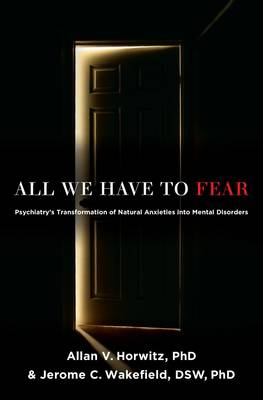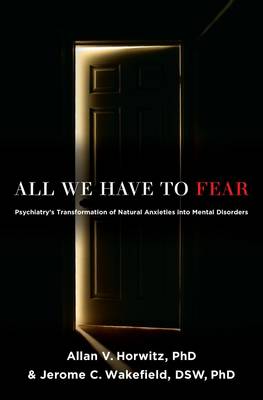
En raison d'une grêve chez bpost, votre commande pourrait être retardée. Vous avez besoin d’un livre rapidement ? Nos magasins vous accueillent à bras ouverts !
- Retrait gratuit dans votre magasin Club
- 7.000.000 titres dans notre catalogue
- Payer en toute sécurité
- Toujours un magasin près de chez vous
En raison de la grêve chez bpost, votre commande pourrait être retardée. Vous avez besoin d’un livre rapidement ? Nos magasins vous accueillent à bras ouverts !
- Retrait gratuit dans votre magasin Club
- 7.000.0000 titres dans notre catalogue
- Payer en toute sécurité
- Toujours un magasin près de chez vous
All We Have to Fear
Psychiatry's Transformation of Natural Anxieties into Mental Disorders
Allan V Horwitz Phd, Jerome C Wakefield
Livre relié | Anglais
61,45 €
+ 122 points
Description
Thirty years ago, it was estimated that less than five percent of the population had an anxiety disorder. Today, some estimates are over fifty percent, a tenfold increase. Is this dramatic rise evidence of a real medical epidemic? In All We Have to Fear, Allan Horwitz and Jerome Wakefield argue that psychiatry itself has largely generated this "epidemic" by inflating many natural fears into psychiatric disorders, leading to the over-diagnosis of anxiety disorders and the over-prescription of anxiety-reducing drugs. American psychiatry currently identifies disordered anxiety as irrational anxiety disproportionate to a real threat. Horwitz and Wakefield argue, to the contrary, that it can be a perfectly normal part of our nature to fear things that are not at all dangerous--from heights to negative judgments by others to scenes that remind us of past threats (as in some forms of PTSD). Indeed, this book argues strongly against the tendency to call any distressing condition a "mental disorder." To counter this trend, the authors provide an innovative and nuanced way to distinguish between anxiety conditions that are psychiatric disorders and likely require medical treatment and those that are not--the latter
including anxieties that seem irrational but are the natural products of evolution. The authors show that many commonly diagnosed "irrational" fears--such as a fear of snakes, strangers, or social evaluation--have evolved over time in response to situations that posed serious risks to humans in the past, but are no longer dangerous today. Drawing on a wide range of disciplines including psychiatry, evolutionary psychology, sociology, anthropology, and history, the book illuminates the nature of anxiety in America, making a major contribution to our understanding of mental health.
including anxieties that seem irrational but are the natural products of evolution. The authors show that many commonly diagnosed "irrational" fears--such as a fear of snakes, strangers, or social evaluation--have evolved over time in response to situations that posed serious risks to humans in the past, but are no longer dangerous today. Drawing on a wide range of disciplines including psychiatry, evolutionary psychology, sociology, anthropology, and history, the book illuminates the nature of anxiety in America, making a major contribution to our understanding of mental health.
Spécifications
Parties prenantes
- Auteur(s) :
- Editeur:
Contenu
- Nombre de pages :
- 320
- Langue:
- Anglais
Caractéristiques
- EAN:
- 9780199793754
- Date de parution :
- 01-06-12
- Format:
- Livre relié
- Format numérique:
- Genaaid
- Dimensions :
- 236 mm x 160 mm
- Poids :
- 581 g

Les avis
Nous publions uniquement les avis qui respectent les conditions requises. Consultez nos conditions pour les avis.






